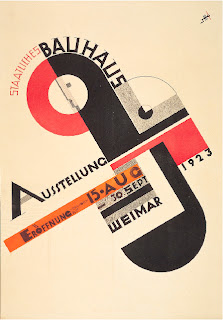 |
| El Lissitzky, For the voice, 1923 |
I've arrived at a conclusion, which is a direct result of me producing the case study on the Italian Futurists, that many art movements from the 1915-1945 period will inspire me in my future work. I think this because, I like the way the constructivists and the Futurist use simply geometric shapes in their work. The piece of artwork to the right is called 'For the voice' by El Lissitzky, in this artwork he has used simply shapes to create a effective piece of artwork.
Bauhuas
 |
| Joost Schmidt, 1923, A poster for the Bauhaus Exhibition in Weimar. |
I believe that there should be more schools like the Bauhaus at present time. The artists of the school wanted to change the teaching techniques from the 1-2-1 method to creating a community of artists all working together, to bring art into everyday life. The artwork to the left is a poster for the Bauhaus exhibition in Weimar, designed by Joost Schmidt.
No comments:
Post a Comment